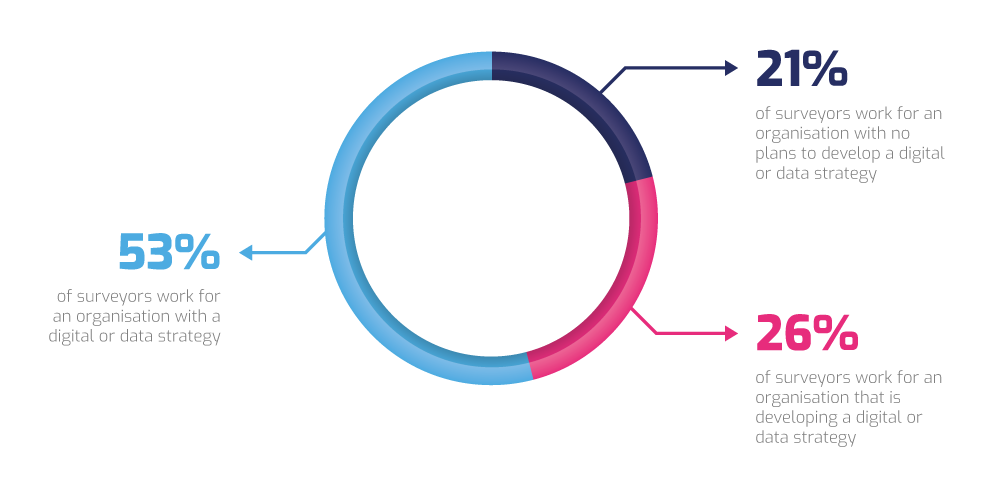The cloud revolution in surveying is already here: what does it mean for surveyors?

The pace of change in the adoption of technology, and especially cloud computing is accelerating. According to a recent RICS survey on the impact of technology on Surveying,
- The use of technology by surveyors has increased from 60% to 68% in two years.
- Those with a digital strategy in place (or working on one) has risen from 57% to 79%.
- 95% of respondents said that the cloud presents an opportunity.

Central to this change has been the widespread use of 3D scanners and the adoption of cloud computing to process, share and distribute the resulting point cloud data. We’ve written a guide for surveyors looking to prepare for this change called “Are you ready for the cloud?” — check that out for more detail.
With that in mind, here are the key areas that the cloud will impact, and a few things you should be doing to get on board.
1. Steep changes in efficiency
Cloud adoption is driving lower costs (in the design, construction and whole life costs of built assets), and increasing productivity (creating efficiencies to reduce time from inception to completion).
Implementing more remote working
Over the last months, we have learned that we can work digitally. There has, perhaps, in the past been a suspicion that remote working discourages productivity. But that simply is not turning out to be the case. Cloud-technology will empower surveyors to continue to embrace remote workflows even after social distancing has ended.
Building in flexibility
In the future, certain elements may become more of a common occurrence, such as the need to close down a site and open up again in short notice. By using the cloud, processes can become more “agile”, taking advantage of the ability to scale up and scale down resources as and when needed.
Making use of processing power
Organisations need robust processes to read, analyse and share their data. Cloud-based solutions offer higher-powered options that can be scaled up and down when needed to get the job done quicker. This is useful for augmenting the processing power of smaller field computers. However, the ability of some point cloud processing software to parallelise tasks means that the near limitless scalability of cloud computing resources can dramatically accelerate the time it takes to process scan data. Check out our article on managing large point cloud data sets for more details.
Automated scans
Some programs can automatically start registering scans into a composite point cloud as they are uploaded. This approach can speed up the process and even help surveyors access completed point cloud data from their worksite.
What you can do today
- Review your processes and workflows.
- Take advantage of current remote working opportunities.
- Start prototypes and learn about using new cloud-based proptech.
2. Sharing and collaboration
True collaboration requires a cultural change, a culture where responsibility, risk and reward are proportionately shared and collectively owned. The cloud is a better way to deliver client requirements, increase efficiency and reduce disputes.
To be successful, the move to collaboration needs to happen within organisations also, and cloud technologies are helping practices to collaborate both internally and externally.
The cloud improves accessibility to results and data, and provides links directly to other technical innovations such as the use of Building information Modelling (BIM) or the Internet of Things (IoT). The role of the surveyor is changing and the cloud is helping integrate that role into the new emerging “business-as-usual”.
Bringing BIM to life
The rapid emergence of Building Information Modelling (BIM) continues to revolutionise the way architecture, engineering and construction firms work together to communicate, solve problems and build better projects.
BIM is a collaborative process of generating, managing and sharing information between project stakeholders. It helps maintain clarity and transparency among project members,
Done well, BIM lowers the frequency and possibility of mistakes, reduces human error, and can avert project conflicts. It’s also being partnered with point cloud processing to deliver ‘scan-to-BIM’ workflows and as-built BIM outcomes. This allows all deviations from planning to be captured in the final BIM, and the application of BIM best practices in renovation projects.
Shareability
With BIM as a catalyst (the 2019 NBS National BIM Report found that 69% of respondents were aware of and using BIM) many surveyors are now working with a variety of partners, including contractors, engineers and other stakeholders.
Cloud services make sharing data with third parties much more straightforward than before. Surveyors, management, engineers, clients and more can share information quickly and with controlled permissions, improving collaboration. In the era of digitalisation and a need for remote working, cloud is offering a new approach to digital asset management.
Cloud helps you to share and access data more easily, avoiding misinformation or outdated files. It eliminates the need to send files, which is essentially copying and redownloading them, which often results in duplicates or unnecessary data. With the cloud, users not only can access the same data, they can do so from a range of devices wherever they have a connection.
Sharing and collaboration in the cloud is already delivering tangible benefits:
- No more sending heavy point clouds and pdf reports via email.
- No more having the wrong version of the files.
- Reduce the number of client face-to-face meetings by using conferencing.
What you can do today
- Sign-up to a collaborative cloud service — Microsoft Teams or Slack are good starting points.
- Get your own team collaborating on-line.
- Investigate BIM and start the ISO certification process.
- Collaborate with like-minded stakeholders to start pilots and review processes.
3. Simplicity of cloud storage
Surveyors can store data for thousands of projects, and they can repeatedly outgrow their capacity as they accumulate more projects and business. Storage infrastructure can be costly and time-consuming. Many surveyors are using cloud storage to offset these problems and let someone else manage the challenges involved,
Cloud storage companies also offer security expertise. Many surveyors are taking advantage of these added-value services to work with their cloud storage providers to address a range of data issues including not only security, but privacy and data ownership issues.
What you can do today
1. Create an outline data storage plan for-
- Local
- Shared
- Archived
- Business continuity
2. Create a data security plan
3. Start to upload back-ups of your data to the cloud
4. Calculate the costs of your storage plan and monitor regularly
4. Digital transformation in a time of change
Cloud is at the centre of the digital transformation of the surveying profession. Reimagining how we bring together people, data and processes to create value and better outcomes.
In this digital-first world, surveyors are already exploiting a range of cloud tools:
- video conferencing,
- powerful surveying apps
- hardware such as laptops and tablets
- the 5G internet
- social media
Innovations that will continue to transform how surveyors work include:
- Mobile 3D scanning
- Drones (for scanning and maintenance)
- AR/VR
- IoT/digital sensors
In some ways, we are in the middle of an enforced social experiment that will hasten this cloud transformation. Many processes will be reviewed and speeded up as a result. The current situation will accelerate the change that has been predicted for some time.
Fundamentally, the cloud allows surveyors to be more flexible, collaborate more effectively, deliver outputs faster while being more efficient. As a result, surveyors are able to take on new and different types of jobs, and work within those teams in a more integrated fashion. Pushing the limits of what this means for the industry has yet to be seen, and is up to innovative surveyors to determine.
What might have taken five years to implement, is now unfolding at a rapid pace. Surveyors need to be ready for cultural and process changes. But that all rests on the ability to manage the technical transformation. If you are still worried about that change — Check out our eBook “Are you ready for the cloud?”
Tags: surveying


